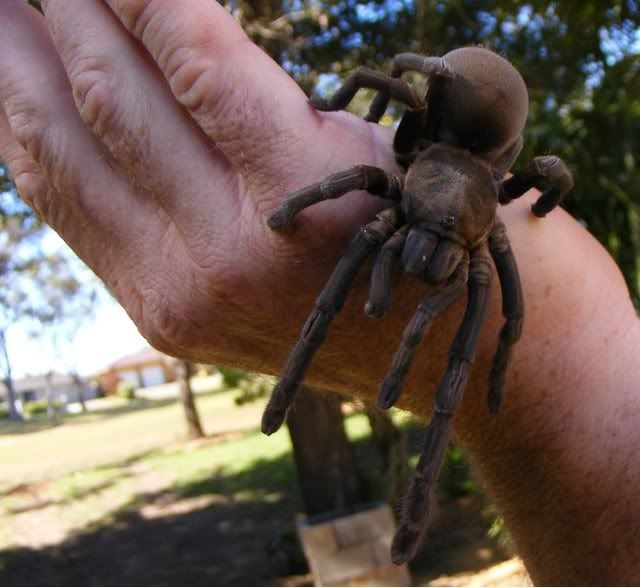
A big, healthy, well fed female Phlogius crassipes hanging from my friend Greg Bylund's hand saying cheese!
Thanks to Grant Miller (copyright 2008) for kind access to the above picture taken on a visit to Greg's house in August 2008.
Thanks to Grant Miller (copyright 2008) for kind access to the above picture taken on a visit to Greg's house in August 2008.
You may have seen reports in the press about an Australian tarantula invasion eg. in this Times Online article.
Just to add a little sanity to the hysteria (party pooper I know) I will paste a response I made on another forum to questions about the truth of this article and similar articles popping up:
This story is a beat up and is the usual case of the press going for sensational rubbish to sell product. First Bowen is hardly an "outback" town. It is a small coastal town in the mid north coast region of Queensland. The article notes that but the headline does not. Quite a nice little place with friendly people and very sleepy.
Second - the spiders are indeed tarantulas - Selenocosmia (Phlogius) crassipes which are common in the region and have been found and known there for a very long time and in fact the original type specimen for what was then known as Phrictus crassipes comes from Bowen and was described by Koch in 1874. There would probably have been a lot more around back then but obviously our forefathers had a higher threshold for hysteria and did not in over a century complain of being invaded.
A pest exterminator in another article was quoted as saying 10 tarantulas had been found - hardly an invasion. Even in the article in question although the headline says INVASION and the article says the the exterminator had been "innundated with calls" when it quotes him he says, "There have been a number of reports. It's not plague proportions but a number have been spotted around the district.” Not an invasion by any stretch of the imagination. Apparantly they are wandering and in search of females later in the season than usual due to high humidity of recent rains. This is where they live; this is what they do. Of course normally being an opportunistic burrower they operate under the radar and usually go unnoticed.
In another article the exterminator said: "They (The Times) were obviously looking at the sensational side of it, but I basically set them straight that it wasn't thousands of the things crawling around attacking people or anything like that, there were just a few that had been sighted," Mr Geiszler said.
You should start with the premise anything you read in the press is wrong or at best highly misleading until proven otherwise.
I have even been contacted by the press in some European countries for a photograph of this species from my blog so it looks like there has been a lot of interest in this invasion - run for your lives, the world is coming to an end and we're all going to die. Spare us please. I am just waiting now for the press to somehow blame the whole thing on global warming and then the party can really start. "Scientists warn that global warming will lead to annihilation of the human species by giant tarantulas!" - remember - you saw that here first.
The bite of Phlogius crassipes can make you sick and it will kill a dog or cat if they are invenomated but not what I would think you would call highly toxic. Keepers here get bitten occassionally and usually don't even bother going to hospital to get checked (probably smart to do). For more information see Bites by spiders of the family Theraphosidae in humans and canines, Geoffrey K. Isbistera,*, Jamie E. Seymourb, Michael R. Grayc, Robert J. Ravend in Toxicon (Toxicon 41 (2003) 519–524). The study notes: "The nine spider-bites in humans caused only minor effects. Local pain and puncture marks were the commonest clinical effects" and concludes "The study suggests that bites by these spiders are unlikely to cause major problems in humans. The study also demonstrates that the venom appears to be far more toxic to canines than humans with a 100% case fatality rate in the study." Vomiting and discomfort for some hours is likely to be the strongest reaction you will get form the species in question.
Now that the area is drying out after the rains they will all soon die or retreat back to suitable burrows where they will get the humidity and warmth they need to survive.
Now that's cleared up can we please return to our regularly scheduled end of the world panic from, say, global warming, swine flu or suitcase nuclear bombs and such?






One of the scariest, but coolest photos i have seen :) They are huuuge Charles! Amanda.
ReplyDeleteI recently received a Phlogius crassipes. She is still a 1.5 inch sling, but is very sweet. I have 60 tarantulas at the moment and have seen aggression out of only three or four of them. Have been bitten by two, a C. brachycephalus and a P. striata. My P. crassipes has never shown any hostility or ever done a threat display. I think they are wonderful animals, and I'm glad you set the record strait about this "Invasion". Thanks for your article : )
ReplyDeleteCheers,
Michael
renaissance659@ymail.com